|
The best defense against insects is to have a thick healthy lawn (see our Lawn Care section for more information). A thick healthy lawn can withstand some insect infestation without too much damage. Contact your local lawn care professional for proper diagnosis and treatment.
Southern Ontario
Turfgrass Insect Activity Time Profile
 |
Jan |
Feb |
Mar |
Apr |
May |
Jun |
Jul |
Aug |
Sep |
Oct |
Nov |
Dec |
| Black Turfgrass Ataenius |
   
    |
| European Chafer Grub |
 
    |
| June Beetle Yr 1 |
   
    |
| June Beetle Yr 2 |
   
    |
| June Beetle Yr 3 |
 
  |
| European Crane Fly (Leatherjacket) |
 
  |
| Bluegrass Billbug |
 
  |
| Chinch Bug |
 
  |
| Turfgrass Scale |
 
  |
| Sod Webworm |
 
  |
| Black Cutworm |
 
  |
 Period of egg laying Period of egg laying  Period of larval feeding Period of larval feeding |
Ants (Formicdae)
 Ants do not feed on the grass; the problem is the ant hills that they make in the lawn. Ants do not feed on the grass; the problem is the ant hills that they make in the lawn.
Ants can also be a problem when they come onto patios and indoors. Fortunately, ants can be controlled for a small period of time with a recommended insect control material. The insect control should be applied to the entire lawn. If only the ant hills are treated, the ants will move to an untreated area.

Black Turfgrass Ataenius (Ataenius spretulus)
 Young beetles (grubs) are less than 2 mm long when they are hatched and grow to about 5 mm when mature. Young grubs are C-shaped, yellow-brown heads and have 6 legs. When they mature they become black shiny beetles. Young beetles (grubs) are less than 2 mm long when they are hatched and grow to about 5 mm when mature. Young grubs are C-shaped, yellow-brown heads and have 6 legs. When they mature they become black shiny beetles.
Adult beetles are frequently seen in piles of grass clippings, on leaves or in any other decaying vegetation. The grubs feed on the roots causing the lawn to wilt, turn yellow and die out in patches (usually in mid July). The dead patches will continue to increase until the larvae stop feeding. The damaged grass will roll up easily.
Life Cycle:
Adults are active in late May and early June and fly into grassy areas to lay their eggs. Females lay 10 to 12 eggs in the thatch layer. The larvae hatch quickly and feed until the end of July at which time they pupate. Adults appear a short time later and either mate or look for over wintering areas.
Control Options:
The best time to control the Black Turfgrass Ataenius is late May to early June before the females have laid their eggs. Contact your local lawn care professional for proper diagnosis and treatment.

Bluegrass Billbugs (Sphenophorus)
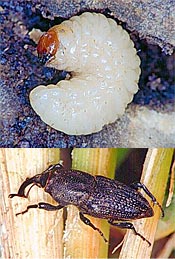 Adult Bluegrass Billbugs are blackish gray in color with a hard body that is about 5mm (3/16") in size. Their long snout‑like forehead can distinguish them. The adults survive in the thatch layer during the growing season. The adults may cause minor damage to the lawn by chewing holes in the grass blades; however, the damage inflicted is minor compared to that of the larvae. During the spring and fall the adults may frequently be spotted traveling along sidewalks and driveways. Adult Bluegrass Billbugs are blackish gray in color with a hard body that is about 5mm (3/16") in size. Their long snout‑like forehead can distinguish them. The adults survive in the thatch layer during the growing season. The adults may cause minor damage to the lawn by chewing holes in the grass blades; however, the damage inflicted is minor compared to that of the larvae. During the spring and fall the adults may frequently be spotted traveling along sidewalks and driveways.
Bluegrass Billbugs do most of the damage while they’re in larvae stage. Larvae are legless with fat whitish body and a brown head. They feed on the grass roots and stems, often cutting the roots and stems of the grass off, allowing the plant to be pulled up easily.
Bluegrass Billbug damage resembles drought symptoms. Large areas of your lawn may appear wilted with a yellowish brown color, however it will not respond to watering.
Life Cycle:
Bluegrass Billbugs have a one year life cycle. They survive the winter as adults living in protected areas such as gardens. Early in the spring they emerge. By late June the females begin depositing their eggs in the lawn and the eggs begin to hatch in about two weeks. The young feed on the grass plants while moving into the soil. Serious damage may occur in the summer. If the problem is ignored, the brown patches will get larger and damaged areas will then fill in with weeds or crabgrass.
Control Options:
The best time to control the Bluegrass Billbug is when they are very young (June‑July). By early fall they begin to transform into adults. While in the adult stage they are extremely difficult to control. Removing thatch by aeration or dethatching will also help. Contact your local lawn care professional for proper diagnosis and treatment.

Chinch Bug (Blissus leucopterus)
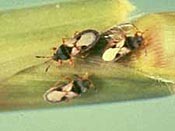 Chinch bugs have reddish bodies in their younger stages. The tiny young mature into black and white coloured adults. They live above the soil and feed on living grass plants. Chinch bugs pierce the grass blade, stem or crown, inject toxic saliva, then suck out the plant’s sap. Damage looks similar to drought but watering does not remedy the problem. Chinch bugs have reddish bodies in their younger stages. The tiny young mature into black and white coloured adults. They live above the soil and feed on living grass plants. Chinch bugs pierce the grass blade, stem or crown, inject toxic saliva, then suck out the plant’s sap. Damage looks similar to drought but watering does not remedy the problem.
Chinch bugs attack during the mid‑summer heat and can cause serious damage in a few days and devastate an entire lawn in a few weeks.
Life Cycle:
Chinch bugs survive the winter as adults, seeking shelter from cold and snow under hedges, shrubs and leaves. In late spring they come out of hiding to mate and lay eggs. Each adult female lays about 250 eggs, which hatch after about three weeks. When the eggs hatch the young nymphs begin feeding and cause noticeable damage immediately. After the first generation, it is possible that two or more generations will be born and mature each year.
Control Options:
It is very important to diagnose and control Chinch bugs quickly. Contact your local lawn care professional for proper diagnosis and treatment.

Cutworm (Family: Noctuidae Genera: Agrotis, Nephelodes, Peridroma)
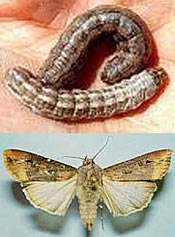 Cutworm larvae are grey, brown or black. They live on the soil surface or in the thatch layer. Cutworm larvae usually feed during the night and take shelter in the day. Stems, leaves and roots of grass plants may be injured, leaving yellowish brown dead patches with a hollow hole in the middle of the circle. Other symptoms to watch for include looking for starlings and other birds that keep returning to an area and leaving holes in the lawn. Cutworm larvae are grey, brown or black. They live on the soil surface or in the thatch layer. Cutworm larvae usually feed during the night and take shelter in the day. Stems, leaves and roots of grass plants may be injured, leaving yellowish brown dead patches with a hollow hole in the middle of the circle. Other symptoms to watch for include looking for starlings and other birds that keep returning to an area and leaving holes in the lawn.
Life Cycle:
The adult appears in the spring as a greyish brown moth. Adult cutworms do not damage lawns, they lay their eggs on the grass blades in the spring during the night. Larvae emerge and begin feeding as early as June with damage appearing in June-July. Dead patches of grass begin to appear and may be pulled away easily by hand.
Control Options:
Contact your local lawn care professional for proper diagnosis and treatment.

European Chafer Grub (Rhizotrogus majalis)
 They are C-shaped, cream coloured with a brown head and have six legs. The larvae are small, plump, and actively feed on grass roots. They live below the soil surface and actually chew off the roots of the grass. They are C-shaped, cream coloured with a brown head and have six legs. The larvae are small, plump, and actively feed on grass roots. They live below the soil surface and actually chew off the roots of the grass.
After they destroy the grass roots, the lawn will appear unhealthy, turning yellow then brown, as if the lawn is drying out. Other symptoms to watch for include: presence of birds, moles, skunks and other insect-eating animals. Skunks and raccoons will dig up the lawn and birds leave holes where grubs are present. The damaged grass will roll up easily.
Life Cycle:
These grubs complete their life cycle in one year surviving as larvae in the soil over winter. In the early spring they begin to feed again and pupates into the European Chafer, around mid to late June. The beetles come out of the soil and fly to trees where they mate. Adults are active for two to three weeks, during this time the female can deposit 25 to 50 eggs which will hatch into grub larvae. The larvae hatch in mid to late July and become mature larvae 7 to 8 weeks later, (September) and feed on the grass crowns and roots until late fall. The mature grub moves down into the soil as the soil freezes and will return to the surface in early April.
Control Options:
The best time to control grubs is in August. Contact your local lawn care professional for proper diagnosis and treatment.

Japanese Beetle (Popillia japonica)
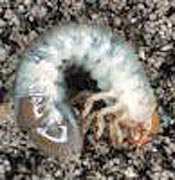 The Japanese beetle is highly destructive during both its larval and adult stages. The larval stage is responsible for the damage done to your lawn and the adult stage is more damaging to ornamental plants. The grubs are about 1” long when mature, white to cream colored, has a dark head, 6 legs and a C-shaped body. The Japanese beetle is highly destructive during both its larval and adult stages. The larval stage is responsible for the damage done to your lawn and the adult stage is more damaging to ornamental plants. The grubs are about 1” long when mature, white to cream colored, has a dark head, 6 legs and a C-shaped body.
The lawn wilts, turns yellow then brown during August or September. The damaged grass will roll up easily. Damage to your lawn also occurs when moles, raccoons, skunks dig up your lawn looking for food.
Life Cycle:
The adult beetle usually emerges during the first 2 weeks of July. They live from 30 to 45 days and feed on a wide variety of plants. Each female may lay 40 to 60 eggs in the soil. The larvae hatches in two weeks and begins to feed on roots. The larvae mature by late October and move down into the soil to over winter. The following spring they resurface to feed before they pupate in June. Fall and spring are when most turf damage may occur by larvae.
Control Options:
The best times to control the larvae are in the months of July to September. Contact your local lawn care professional for proper diagnosis and treatment.

June Beetle (Phyllophaga)
 June beetles have a 3 year life cycle with grub damage usually occurring every 3 years. Adult June beetles are black or brown and are about 1” in length with long, spiny legs. The larvae are small when first hatched but can get to a length of 3 cm to 4 cm when full grown. They have a tan or dark brown head, 6 legs and have two parallel rows of spines. June beetles have a 3 year life cycle with grub damage usually occurring every 3 years. Adult June beetles are black or brown and are about 1” in length with long, spiny legs. The larvae are small when first hatched but can get to a length of 3 cm to 4 cm when full grown. They have a tan or dark brown head, 6 legs and have two parallel rows of spines.
The grubs feed on the roots causing the lawn to wilt, turn yellow and die out in patches. The damaged grass will roll up easily. Damage to your lawn also occurs when moles, raccoons, skunks dig up your lawn looking for food.
Life Cycle:
It takes three years to develop into the June Beetle. Large numbers of adults fly at night time in late May or June. Females lay their eggs in late May or June and the eggs hatch in a few weeks. The small larvae feed on the grass for the rest of the summer and then move down into the soil to over winter. The second year is when the most damage occurs as the grub feeds from spring until early fall, then moves down into the soil to over winter again. The third year the grub resurfaces, feeds for a short time and then molts into pupal stage. The pupa matures into adults during midsummer. The adults stay in the soil to emerge the following spring and then the cycle repeats.
Control Options:
The best time to control the June Beetle larvae is in the first year when they are small in the months of late July to early September. Contact your local lawn care professional for proper diagnosis and treatment.

Leatherjacket or European Crane Fly (Tipula paludosa, T. oleracea)
 Due to their leathery grey brown skin, the damaging larvae are commonly referred to as "Leatherjackets". Leatherjackets feed during the day at or below the surface of the lawn. The damage to your lawn will first appear as brown patches that soon become bare if infestations are heavy. The insect is most visible on damp, warm nights when they feed on grass blades and stems at the soil surface. Due to their leathery grey brown skin, the damaging larvae are commonly referred to as "Leatherjackets". Leatherjackets feed during the day at or below the surface of the lawn. The damage to your lawn will first appear as brown patches that soon become bare if infestations are heavy. The insect is most visible on damp, warm nights when they feed on grass blades and stems at the soil surface.
Life Cycle:
The adult crane fly looks like a giant mosquito and appears in late summer. The female lays black eggs in the grass or soil and the eggs hatch within two weeks and the larvae begin to feed. They feed at the soil level on roots and seedlings almost continuously between August and late May. During the colder periods of winter, they burrow deep into the soil. As the temperatures rises in the spring, they will ascend to just below the soil surface and resume feeding.
Control Options:
There is no way to spray for the adult European Crane Fly. Contact your local lawn care professional for proper diagnosis and treatment.

Sod Webworm (Parapediasia)
 Sod Webworm adults are small tan moths. The adult moths do not harm your lawn but when disturbed they are seen flying across your lawn. They usually hide during the day and come out in the evening. The adult moths will be seen about three weeks before any damage appears. Sod Webworm adults are small tan moths. The adult moths do not harm your lawn but when disturbed they are seen flying across your lawn. They usually hide during the day and come out in the evening. The adult moths will be seen about three weeks before any damage appears.
The larvae stage of the Sod Webworm: they are about 3/4" long, are dirty white or tan in colored and frequently have rows of dark spots along their back. As larvae, they construct burrows in the thatch layer. The insect lines its tunnel with 'silk‑like' material and green excrement (frass) on the surface.
Life Cycle:
The adults emerge by late May or early June and come out mainly during the evening hours to lay their eggs throughout the lawn. When the larvae emerge from the egg they begin feeding immediately. Damage is caused by the larvae chewing off the grass stems and leaves while feeding during the summer and into early fall. The dead patches of grass will pull away easily in clumps revealing masses of silk-like material with green excrement (frass) left by the larvae.
Control Options:
The best time to control the sod webworm is when they are young before you are faced with severe damage (July-August). By early fall they begin to transform into adults. While in the adult stage they are extremely difficult to control. Contact your local lawn care professional for proper diagnosis and treatment.

Turfgrass Scale (Lecanopsis formicarum)
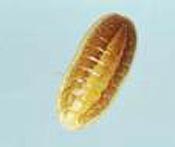 Adult scale is light tan in color with two dark stripes running parallel down their backs and measure about 1.5 mm wide and 2.5 mm long. The adults survive in the thatch layer and may cause minor damage. Large areas of your lawn may appear wilted and brown in color and does not respond to watering. Adult scale is light tan in color with two dark stripes running parallel down their backs and measure about 1.5 mm wide and 2.5 mm long. The adults survive in the thatch layer and may cause minor damage. Large areas of your lawn may appear wilted and brown in color and does not respond to watering.
Nymphs (young scale) appear in the late spring and summer and increase the damage as they are feeding off the grass. They look like pink pinhead size dots and are frequently spotted in large numbers clinging to grass blades.
Life Cycle:
Scale survives the winter as mature nymphs only; they become adults in May and June and produce about 400 salmon-pink colored eggs in a cottony mass of silk. The eggs hatch and emerge as crawlers and they begin to feed off grass blades. Crawlers at the peak of their activity will move to the tips of the grass blades, turning the lawn reddish in color. This stage is dispersed by the wind.
Control Options:
The best defense against a scale problem is to promote a thick healthy green lawn as there is no pesticide registered for their control. Contact your local lawn care professional for proper diagnosis.
 |


 Ants do not feed on the grass; the problem is the ant hills that they make in the lawn.
Ants do not feed on the grass; the problem is the ant hills that they make in the lawn. Young beetles (grubs) are less than 2 mm long when they are hatched and grow to about 5 mm when mature. Young grubs are C-shaped, yellow-brown heads and have 6 legs. When they mature they become black shiny beetles.
Young beetles (grubs) are less than 2 mm long when they are hatched and grow to about 5 mm when mature. Young grubs are C-shaped, yellow-brown heads and have 6 legs. When they mature they become black shiny beetles. Adult Bluegrass Billbugs are blackish gray in color with a hard body that is about 5mm (3/16") in size. Their long snout‑like forehead can distinguish them. The adults survive in the thatch layer during the growing season. The adults may cause minor damage to the lawn by chewing holes in the grass blades; however, the damage inflicted is minor compared to that of the larvae. During the spring and fall the adults may frequently be spotted traveling along sidewalks and driveways.
Adult Bluegrass Billbugs are blackish gray in color with a hard body that is about 5mm (3/16") in size. Their long snout‑like forehead can distinguish them. The adults survive in the thatch layer during the growing season. The adults may cause minor damage to the lawn by chewing holes in the grass blades; however, the damage inflicted is minor compared to that of the larvae. During the spring and fall the adults may frequently be spotted traveling along sidewalks and driveways. Chinch bugs have reddish bodies in their younger stages. The tiny young mature into black and white coloured adults. They live above the soil and feed on living grass plants. Chinch bugs pierce the grass blade, stem or crown, inject toxic saliva, then suck out the plant’s sap. Damage looks similar to drought but watering does not remedy the problem.
Chinch bugs have reddish bodies in their younger stages. The tiny young mature into black and white coloured adults. They live above the soil and feed on living grass plants. Chinch bugs pierce the grass blade, stem or crown, inject toxic saliva, then suck out the plant’s sap. Damage looks similar to drought but watering does not remedy the problem. Cutworm larvae are grey, brown or black. They live on the soil surface or in the thatch layer. Cutworm larvae usually feed during the night and take shelter in the day. Stems, leaves and roots of grass plants may be injured, leaving yellowish brown dead patches with a hollow hole in the middle of the circle. Other symptoms to watch for include looking for starlings and other birds that keep returning to an area and leaving holes in the lawn.
Cutworm larvae are grey, brown or black. They live on the soil surface or in the thatch layer. Cutworm larvae usually feed during the night and take shelter in the day. Stems, leaves and roots of grass plants may be injured, leaving yellowish brown dead patches with a hollow hole in the middle of the circle. Other symptoms to watch for include looking for starlings and other birds that keep returning to an area and leaving holes in the lawn. They are C-shaped, cream coloured with a brown head and have six legs. The larvae are small, plump, and actively feed on grass roots. They live below the soil surface and actually chew off the roots of the grass.
They are C-shaped, cream coloured with a brown head and have six legs. The larvae are small, plump, and actively feed on grass roots. They live below the soil surface and actually chew off the roots of the grass.  The Japanese beetle is highly destructive during both its larval and adult stages. The larval stage is responsible for the damage done to your lawn and the adult stage is more damaging to ornamental plants. The grubs are about 1” long when mature, white to cream colored, has a dark head, 6 legs and a C-shaped body.
The Japanese beetle is highly destructive during both its larval and adult stages. The larval stage is responsible for the damage done to your lawn and the adult stage is more damaging to ornamental plants. The grubs are about 1” long when mature, white to cream colored, has a dark head, 6 legs and a C-shaped body.  June beetles have a 3 year life cycle with grub damage usually occurring every 3 years. Adult June beetles are black or brown and are about 1” in length with long, spiny legs. The larvae are small when first hatched but can get to a length of 3 cm to 4 cm when full grown. They have a tan or dark brown head, 6 legs and have two parallel rows of spines.
June beetles have a 3 year life cycle with grub damage usually occurring every 3 years. Adult June beetles are black or brown and are about 1” in length with long, spiny legs. The larvae are small when first hatched but can get to a length of 3 cm to 4 cm when full grown. They have a tan or dark brown head, 6 legs and have two parallel rows of spines. Due to their leathery grey brown skin, the damaging larvae are commonly referred to as "Leatherjackets". Leatherjackets feed during the day at or below the surface of the lawn. The damage to your lawn will first appear as brown patches that soon become bare if infestations are heavy. The insect is most visible on damp, warm nights when they feed on grass blades and stems at the soil surface.
Due to their leathery grey brown skin, the damaging larvae are commonly referred to as "Leatherjackets". Leatherjackets feed during the day at or below the surface of the lawn. The damage to your lawn will first appear as brown patches that soon become bare if infestations are heavy. The insect is most visible on damp, warm nights when they feed on grass blades and stems at the soil surface. Sod Webworm adults are small tan moths. The adult moths do not harm your lawn but when disturbed they are seen flying across your lawn. They usually hide during the day and come out in the evening. The adult moths will be seen about three weeks before any damage appears.
Sod Webworm adults are small tan moths. The adult moths do not harm your lawn but when disturbed they are seen flying across your lawn. They usually hide during the day and come out in the evening. The adult moths will be seen about three weeks before any damage appears. Adult scale is light tan in color with two dark stripes running parallel down their backs and measure about 1.5 mm wide and 2.5 mm long. The adults survive in the thatch layer and may cause minor damage. Large areas of your lawn may appear wilted and brown in color and does not respond to watering.
Adult scale is light tan in color with two dark stripes running parallel down their backs and measure about 1.5 mm wide and 2.5 mm long. The adults survive in the thatch layer and may cause minor damage. Large areas of your lawn may appear wilted and brown in color and does not respond to watering.